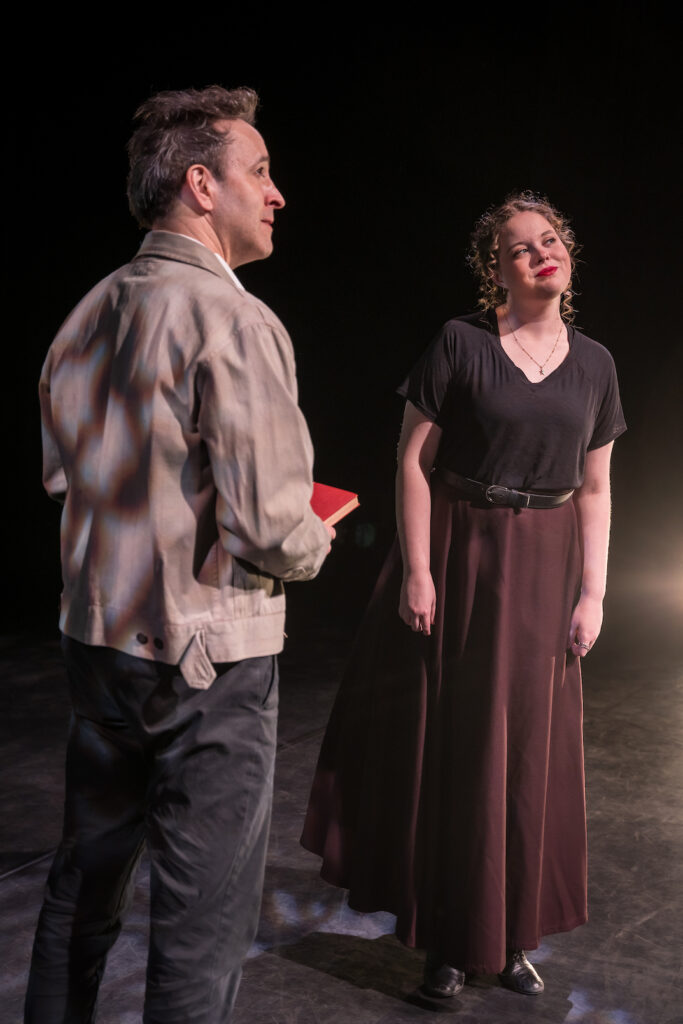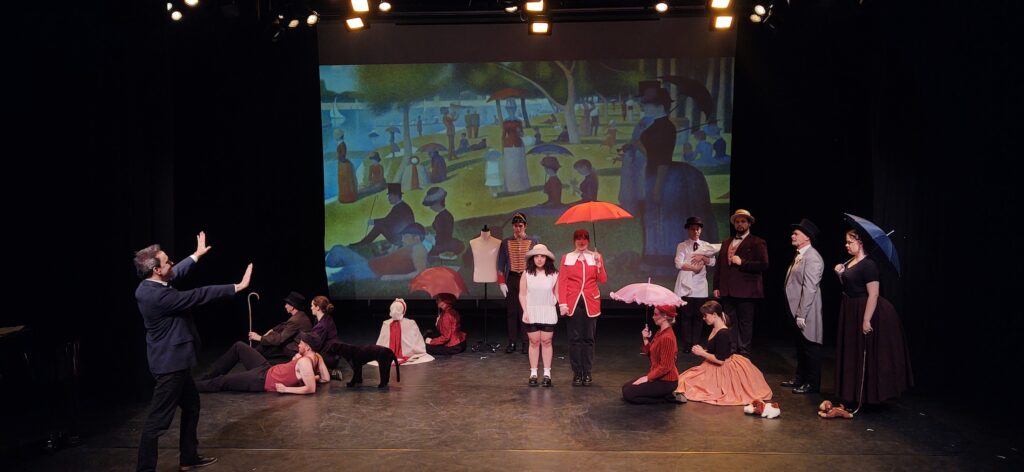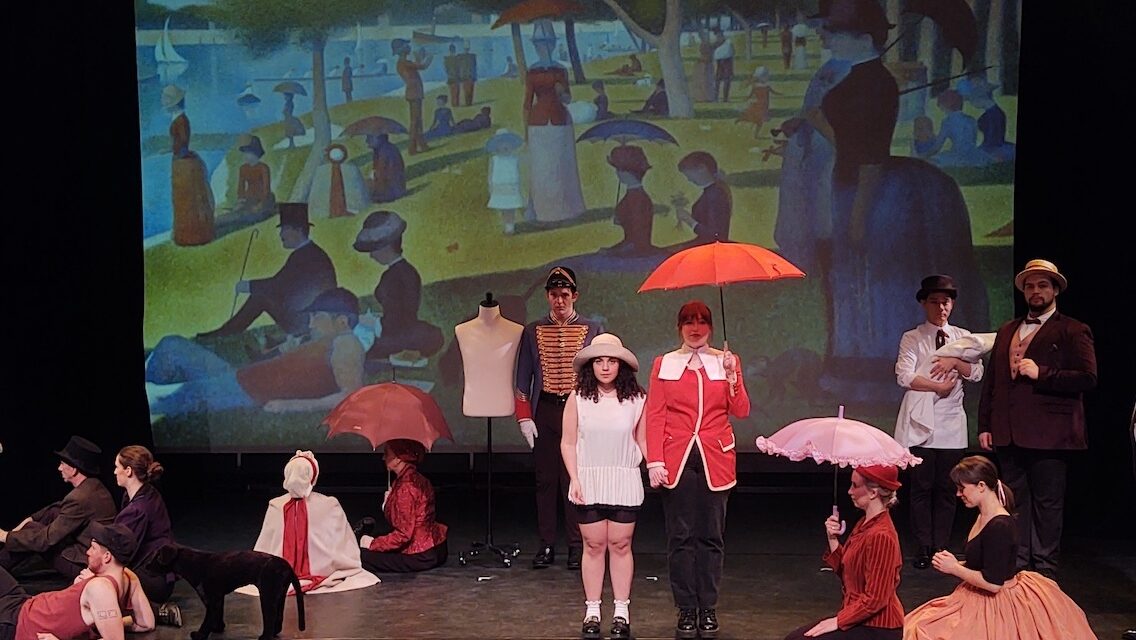By Myra Chanin . . .
Sunday in the Park with George (and Stephen)—hereinafter SITPWG—is a masterpiece about a masterpiece. George is Georges Seurat, the obsessed impressionist painter who discovered a new way of perceiving the world and then doubled down by devising an even newer technique to illustrate his vision, other than the usual blending of pigments on a palette and brushing the blended hues onto a canvas. Seurat’s artistic personality combined qualities considered opposed and incompatible. He had an extreme and delicate sensibility and a mathematically precise passion for logical abstraction. Let’s not exclude his unbelievable patience which allowed him to apply contrasting dots of colors that were optically unified by the human eye and perceived as a single shade or hue.
It took Seurat two years to complete his most ambitious work, the seven-by-ten-foot canvas called A Sunday Afternoon on the Island of La Grande Jatte. He painted it one dot at a time. Seurat considered his technique a form of neo-impressionism, but the “Art Critics” called it pointillism . . . to ridicule him. Who and where are they now? They are found in the anonymous dust in Paris’s Cimetière du Père-Lachaise. As for Seurat, his masterpiece hangs in the Art Institute of Chicago and, per Wikipedia, is now worth (at auction) $782,552,814.33 in good old Yankee greenbacks.

In 1980, Sondheim and his producer Hal Prince were on a helluva roll: Company, Follies, A Little Night Music, and finally the Tony- and Olivier- Award-winning Sweeney Todd which, despite being the darkest musical ever written, lasted for 557 performances on the Great White Way. Sondheim’s next offering, Merrily We Roll Along, with a surprisingly melodic and syncopated score, survived a series of chaotic previews, but received such bad reviews that it only ran for 16 performances. Sondheim felt the animosity towards Merrily was personal. It seemed as if the Broadway community wanted him and Hal Prince to fail.
Sondheim considered throwing in the towel but ultimately decided to start afresh. His new librettist, James Lapine, showed Sondheim photos of paintings to get his creative juices flowing. Only Seurat’s La Grande Jatte struck him as a backdrop for a Broadway show. Did he intuitively recognize that Seurat brought the same kind of methodical intellectual precision to painting that Sondheim brought to songwriting? Was it a match made in heaven? You betcha!
Theater2020, whose production of SITPWG we attended, was also no stranger to tsouris. It began its existence as Theater1010 in a handsome Upper East Side church, where I stumbled into their From Berlin to Broadway. That church was gutted and became a condominium, forcing David Fuller and Judith Jarosz, the Producing Artistic Directors, to rename their company “Theatre2020 Visions for a New Millennium” and move to Brooklyn. I’m a big enough fan of their work to fly to Manhattan from my Florida domicile whenever they perform a Sondheim work.
Act One is about the agony of creation—for instance, making a hat where there was no hat—and George staring at a blank tablet. Lilting arpeggios flutter as he stakes out the essentials needed to bring a canvas to life: design, composition, balance, light and harmony. Can George paint and still hold on to his life with Dot, his constantly quibbling and kvetching Inamorata/model who poses for him while George places the dots of paint that will become her on a canvas of a park? It doesn’t seem likely. The trees appear in the park, are found faulty and are whisked away. George watches the world from a window while he finishes making a hat where there never was one before. One by one some of the characters in the painting come to life and take their places singing melodies that elude but tease you. The first act is spoken rather than sung, like a melodic recitative over a rhythm track. After George once again lists the components of order: Design, Composition, Balance, Light. Harmony, the characters move in front of the canvas and take their places before their pointed replicas. As for Dot, Louis the Baker takes her and the something baking in her oven—her daughter, Marie—to Chicago.


Act Two is about the agony of achieving success as an artist and whether what you gain is worth what you lost. It takes us into the contemporary art world where George, the possible grandson of Seurat, is also an artist who wants to create art that matters, but instead is making repetitious light machines called chromolumes, which bore the art critic who originally approved of them.
George, aware that connections may be more significant than talent, sucks up to museum directors who can get his work exhibited, while continuing the quest for balance and meaning in his artistic life. He flaunts his 91-year-old grandmother, Marie, at gatherings where celebrity can get him clout. Act Two has melodic tunes, syncopated rhythms, life lessons to keep moving on, thoughts about children and art, future generations. The Seurat connection between 1880 and the similarity in the use of dots—pixels now, in computer graphics—including making chromolumes.
What makes Theater2020’s productions especially wonderful is their attention to detail. They select their featured players only after auditioning at least 400 actors. The accompaniment by pianist/musical director Michael O’Dell replaced an entire orchestra. Projection Designer Alex Kopnick’s screens were flawless. Nick ChampRoux’s costumes were deliciously timely. Three cheers for understudy Rae Hillman, who took over the starring role of Dot when the former leading lady was felled by a non-Covid illness on opening night and three days later played the lead without needing to carry a script to refresh her memory. Josh Powell, a real pro and seasoned performer who has played Billy Bigelow, Harold Hill, Juan Peron and The Phantom of the Opera, related to both Georges with feeling, intelligence and glorious musical versatility in two very demanding roles which required his constant presence on stage.
And then there’s producer David Fuller: actor, director, writer, teacher, designer, fight director, puppeteer, technician, critic and arts advocate, who once again outdid himself in every facet.
Because of Covid restrictions, the Mark O’Donnell Theatre is only permitted to seat 61 people per performance, and every one of them at our sold-out performance offered expressions of delight at how well this important play had been staged and performed.
Sunday in the Park with George. Through Sunday March 12 at the Theater 2020’s Mark O’Donnell Theater (160 Schermerhorn Street, Brooklyn Heights) www.theater2020.com
Photos: David Fuller


















